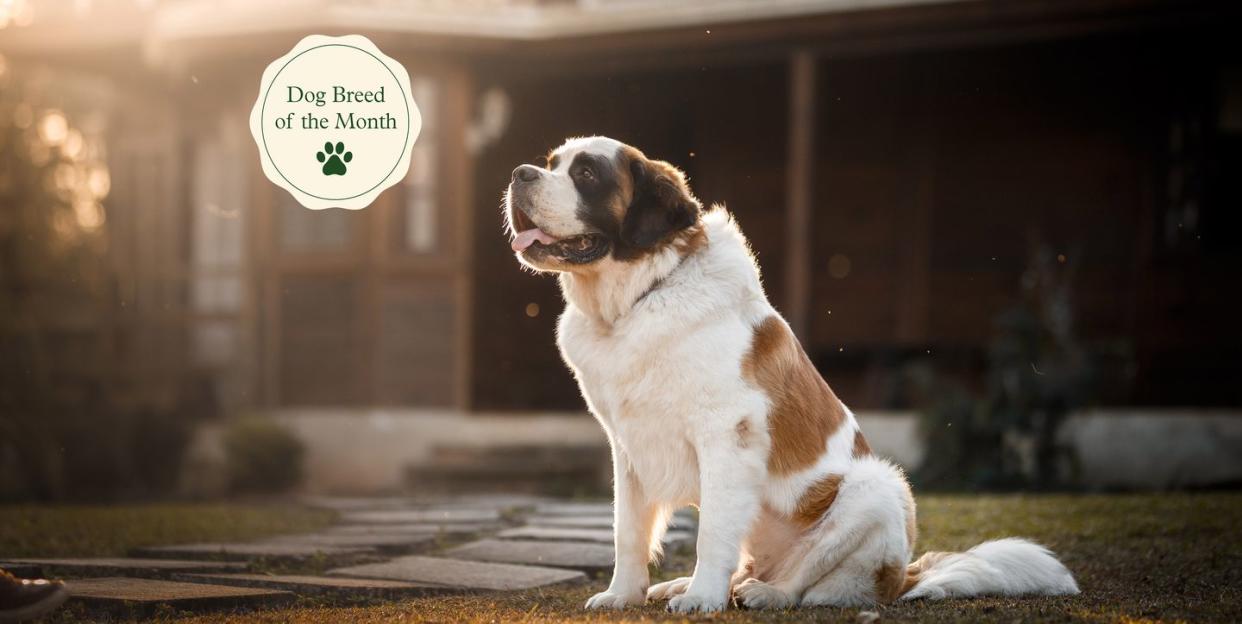6 amazing facts about Saint Bernard dogs

Each month we will be shining a light on different dog breeds in our series, Dog Breed of the Month. Next up, we look at the kind and patient Saint Bernards.
Originally hailing from the Wester Alps of Switzerland, Saint Bernards or St Bernards, were bred as rescue work dogs by the Great St Bernard Pass hospice.
"The St Bernard is a colossal breed with a truly giant skull and lopped ears set high on the head," Dr Linda Simon, Pooch & Mutt's in-house Veterinary Surgeon, tells Country Living. "They can weigh anything from 50kg to 75kg. Coat colours can vary and include red and white, brown and white and brindle and white."
Keep reading for everything you need to know about Saint Bernards, including characteristics and how easy or not they are to train:
What are the main characteristics of Saint Bernards?
"St Bernards need lots of exercise and playtime," PDSA vet, Claire Roberts, tells us. "As with all dogs, they need companionship and shouldn't be left alone for more than four hours in a day."
It's worth knowing that Saint Bernards can be messy pups. Some may slobber on your sofa, while others will leave fur on your sofa.
"Although Saint Bernards do shed a lot, their coat needs a relatively normal level of maintenance from you. Brushing them at least three times a week will help you keep on top of all the dead hair," adds Claire. "You may also choose to have them professionally groomed every few months."

What health problems are Saint Bernards most prone to?
The Saint Bernard typically lives for around eight to 10 years, however, they are prone to some health issues and conditions. Because of the way that they look, The Kennel Club also classes them as a 'Category Three' due to potential problems with their skin folds and teeth.
Other issues they may have include:
• Hip & Elbow Dysplasia: because they are such a large breed, this can have an impact on their joints and as they age, dramatically impact their quality of life. Unfortunately, many older Saint Bernards will suffer chronic arthritis and joint dysplasia in later years.
• Bloat: "All deep-chested dogs are at an increased risk of bloat, or 'gastric dilatation volvulus'," says Dr Linda. "It is unclear why some dogs will develop this condition while others do not. Theories, including diet (wet vs dry), conformation, exercise, and genetics, have all been put forward."
And when a dog does develop bloat, the signs come on rather quickly. Keep an eye out for panting, drooling, restlessness and a tense and bloated abdomen, as prompt treatment is needed to correct the issue.
• Ear Problems: "Due to their pendulous ears, St Bernards are prone to ear infections," says Dr Linda. "This is due to the poor ventilation and the fact that the ear canals tend to become moist and humid. This is the ideal environment for yeast and bacteria to proliferate." The best way to help prevent any infections is by drying ears thoroughly after bath time or swims. Don't forget to clean the ear canals regularly.
"If you are buying from a breeder, make sure the parents have had any relevant health screening tests. We recommend using a Kennel Club Assured breeder, who must follow higher standards and therefore your puppy has a better chance of being happy and healthy," says Claire. "You might choose to rescue a St Bernard from an adoption centre, which should let you know of any health and behaviour problems."
As your Saint Bernard matures, Dr Linda recommends that, much like for any giant breed, you shouldn't over-exercise them as they grow, as this can lead to further joint issues down the line. So, instead of going for a repetitive jog on the pavement, opt for off-lead exercise on grass or sand, instead.
Are Saint Bernards good with children?
One of the friendliest breeds of dogs, Saint Bernards are sometimes even known as a 'nanny' dog because of their kind and careful temperament. They truly are gentle giants with a seemingly never-ending patience.
While they can generally be trusted with and around young children, it is recommended that you always supervise any interaction around little ones.

Are Saint Bernards easy to train?
Because of their size, it is key to train a Saint Bernard when they're still a puppy. A good place to start is with obedience training from an early age. Because they are so incredibly friendly, "they may be prone to jumping up at people," says Dr Linda.
Their good nature means that they are usually relatively easy to train. They also respond well to positive reinforcement – so be sure to have some of their favourite treats at the ready.
6 facts you may not have known about the Saint Bernard
The name Saint Bernard – or St Bernard – was not adopted until 1888. Before then, they were referred to as Alpine Mastiffs
They are Switzerland's national dog
They don't do well in the heat – but their warm and water repellent coats are great for the snow and ice
They didn't carry brandy around their necks during rescues. This myth is thought to come from Edwin Landseer's 1820 painting, 'Alpine Mastiffs Reanimating a Traveller'
They are actually even larger nowadays than they originally were
One of the most famous dogs in film was a Saint Bernard – Beethoven
You Might Also Like


